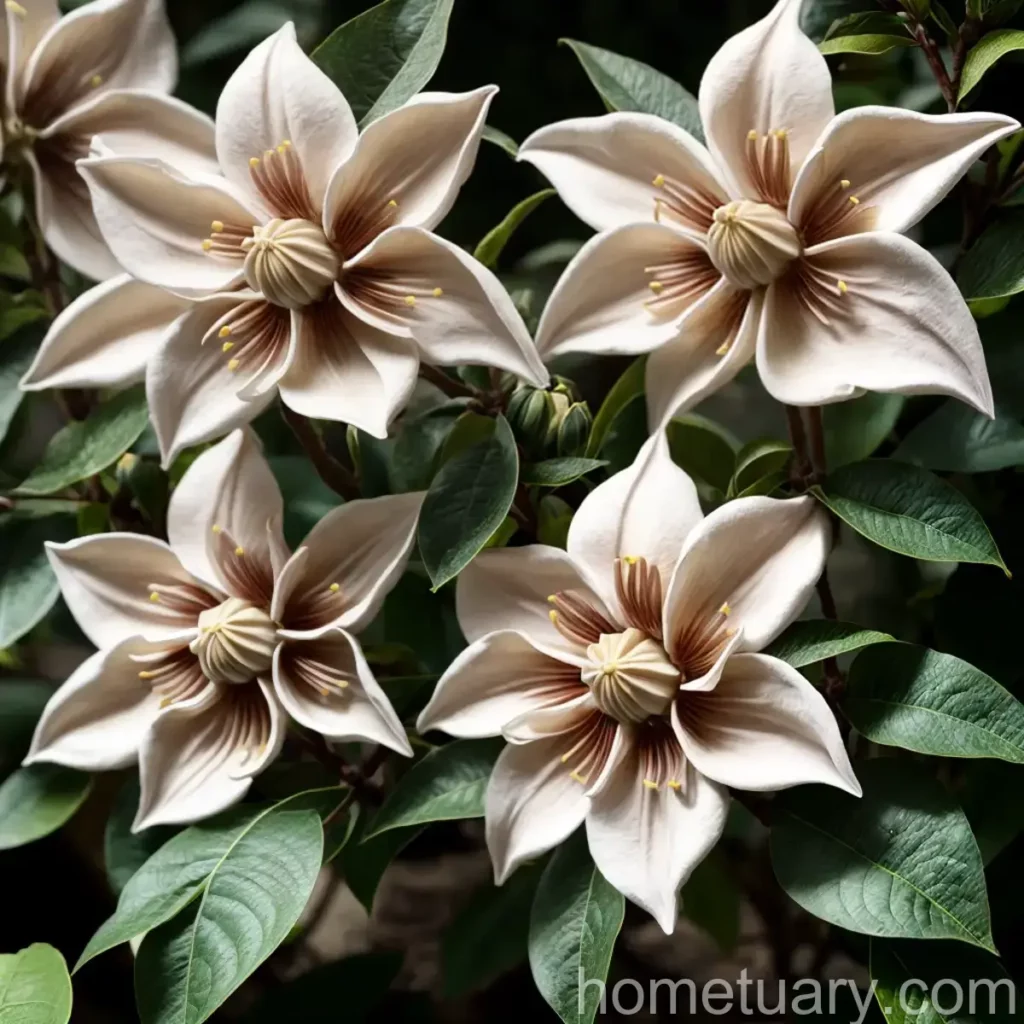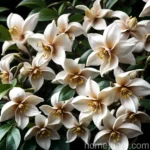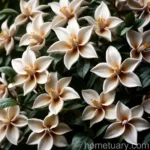Carolina Allspice (Calycanthus ‘Venus’)
Carolina allspice, also known as Calycanthus ‘Venus,’ is a captivating and fragrant shrub that is native to the southeastern United States. Its unique and exotic fragrance, along with its beautiful flowers, make it a popular choice for gardens and landscapes. In this comprehensive guide, we will delve into the various aspects of Carolina allspice, including its culture, uses, maintenance, and interesting facts.
What Is Carolina Allspice (Calycanthus ‘Venus’)?
Carolina allspice, scientifically known as Calycanthus ‘Venus,’ is a deciduous shrub belonging to the Calycanthaceae family. It is a hybrid of Calycanthus floridus and Calycanthus chinensis, resulting in a remarkable combination of traits that make it a valuable addition to gardens and landscapes.
This shrub is renowned for its striking, fragrant, and unique maroon flowers, which exude a sweet and spicy fragrance reminiscent of ripe strawberries and pineapple. The aromatic blooms, coupled with the glossy green foliage, add a touch of elegance and allure to any outdoor space. Carolina allspice is a relatively low-maintenance plant that thrives in various environmental conditions, making it a versatile and sought-after choice for both novice and seasoned gardeners.
Key Takeaways
Before we delve into the specific aspects of Carolina allspice, it’s essential to highlight the key takeaways associated with this captivating shrub.
- Botanical Name: Calycanthus ‘Venus’
- Common Name: Carolina Allspice
- Type: Deciduous shrub
- Fragrance: Exudes a sweet and spicy aroma
- Flowers: Striking maroon blooms
- Cultural Uses: Ornamental, medicinal, and culinary
- Hardiness Zone: 5-9
- Sunlight: Full sun to partial shade
- Soil: Well-drained, fertile soil
- Watering: Regular watering, drought-tolerant once established
- Maintenance: Low to moderate
- Propagation: Seeds, cuttings
- Container Use: Suitable for container planting
- Common Pests: Aphids, spider mites
- Common Diseases: Leaf spot, powdery mildew
With these key takeaways in mind, let’s explore the various facets of Carolina allspice, from its cultural uses to maintenance requirements and fun facts.
Culture
Understanding the cultural requirements of Carolina allspice is crucial for successfully integrating it into garden landscapes. From sunlight and water needs to soil preferences, the culture section will provide insights into creating the ideal growing conditions for this captivating shrub.
Water
Carolina allspice demonstrates moderate water needs, particularly during its establishment phase. While it prefers consistently moist soil, it is also remarkably drought-tolerant once it is firmly established in the garden. Adequate watering is essential during dry spells, especially in the absence of natural rainfall.
Sunlight
In terms of sunlight requirements, Carolina allspice thrives in areas with full sun to partial shade. However, it tends to exhibit the best flowering and overall growth in locations with ample sunlight. When planted in partial shade, it may produce fewer flowers and potentially display weaker growth compared to those situated in sunnier spots.
Soil
Carolina allspice favors well-drained, fertile soil to support its growth and development. The ideal soil pH for this shrub ranges from slightly acidic to slightly alkaline. Moreover, incorporating organic matter into the soil, such as compost or well-rotted manure, can contribute to enhanced soil structure and fertility, promoting healthy growth.
Uses
Carolina allspice serves various purposes, ranging from ornamental uses to its potential in medicinal and culinary applications. Exploring its diverse uses provides valuable insights into the versatility and appeal of this captivating shrub.
Ornamental
One of the primary uses of Carolina allspice is its ornamental value. The striking maroon flowers, coupled with its exquisite fragrance, make it a popular choice for gardens, parks, and landscapes. Whether used as a standalone focal point or incorporated into mixed borders and woodland gardens, Carolina allspice adds a touch of elegance and charm to outdoor spaces.
Medicinal
In addition to its ornamental appeal, Carolina allspice holds historical significance as a medicinal plant. Certain indigenous communities have traditionally utilized various parts of the plant, such as the bark and leaves, for their potential medicinal properties. However, it is essential to consult a healthcare professional before using any plant for medicinal purposes.
Culinary
The aromatic blooms of Carolina allspice possess a captivating fragrance that has sparked interest in its culinary potential. The flowers can be used to infuse a unique and exotic flavor into teas, syrups, and desserts. However, it is crucial to ensure that the variety used for culinary purposes is safe for consumption and free from any harmful compounds.
Fertilizer
When it comes to fertilizing Carolina allspice, a balanced, slow-release fertilizer can be applied in early spring as new growth begins to emerge. A fertilizer with a relatively equal ratio of nitrogen, phosphorus, and potassium, such as a 10-10-10 blend, can support the shrub’s overall growth, flowering, and nutrient requirements.
Applying fertilizer at the base of the shrub, away from the main stem, followed by a thorough watering, can help facilitate nutrient uptake and distribution within the soil. While fertilization can contribute to healthy growth, it is important to avoid excessive or late-season fertilization, which can potentially disrupt the natural growth patterns of the shrub.
Pruning
Pruning plays a significant role in maintaining the shape, size, and overall health of Carolina allspice. Proper pruning techniques can help rejuvenate the shrub, remove dead or damaged growth, and encourage robust flowering. Understanding the principles of pruning is essential for effectively managing Carolina allspice in garden and landscape settings.
Pruning Techniques
Pruning Carolina allspice is typically conducted during the late winter or early spring before new growth emerges. This allows for the removal of any winter damage or dead wood while facilitating the reshaping of the shrub. The following are key pruning techniques for Carolina allspice:
- Removal of Dead or Damaged Growth: Trim away any dead, diseased, or damaged branches to promote healthy growth and maintain the overall appearance of the shrub.
- Thinning Out Overcrowded Growth: Removing overly dense or crowded branches can enhance air circulation and light penetration within the shrub, reducing the risk of disease and promoting even growth.
- Shaping the Shrub: Prune Carolina allspice to maintain a desirable shape and size, ensuring that it integrates harmoniously with the overall garden or landscape design.
Propagation
Carolina allspice can be propagated through various methods, providing gardeners with the opportunity to expand their shrub collection or share this captivating plant with others. Understanding the different propagation techniques enables enthusiasts to propagate Carolina allspice successfully.
Seeds
Propagating Carolina allspice from seeds offers an exciting opportunity to grow new plants from scratch. The following steps outline the process of propagating Carolina allspice from seeds:
- Seed Collection: Gather mature seeds from Carolina allspice once the seed pods have developed and the seeds have ripened.
- Seed Preparation: Scarifying the seeds, which involves lightly nicking or scratching the seed coat, can facilitate germination by allowing water to penetrate the seed.
- Germination: Sow the prepared seeds in a suitable seed-starting mix and keep them consistently moist. Place the container in a warm, bright location to encourage germination.
Cuttings
Propagating Carolina allspice from cuttings offers a reliable and efficient method of producing genetically identical plants. The following guidelines outline the process of propagating Carolina allspice from cuttings:
- Cutting Selection: Select healthy, non-flowering stems for the cutting, typically in the early summer when the shrub is actively growing.
- Cutting Preparation: Prepare the cuttings by removing the lower leaves and making a clean cut just below a leaf node.
- Rooting: Dip the cut end of the stem in a rooting hormone and plant it in a well-draining rooting medium. Enclose the pot and cutting in a plastic bag to maintain high humidity and place it in a warm, bright location.
Container Popularity
Carolina allspice is increasingly gaining popularity as a container plant due to its compact growth habit and ornamental appeal. Its suitability for container planting opens up a world of possibilities for incorporating this captivating shrub into various outdoor spaces, including patios, balconies, and urban gardens.
Benefits of Container Planting
The following are key benefits associated with growing Carolina allspice in containers:
- Versatility: Containers offer the flexibility to position Carolina allspice in different areas of the garden or outdoor space, catering to specific design preferences and spatial constraints.
- Portability: The mobility of container-grown Carolina allspice enables gardeners to rearrange outdoor spaces and create dynamic arrangements based on seasonal or aesthetic considerations.
- Space Optimization: Utilizing containers expands the potential growing areas for Carolina allspice, particularly in urban environments or areas with limited garden space.
Container Requirements
When growing Carolina allspice in containers, it is crucial to consider certain requirements to ensure its optimal growth and performance. The following guidelines outline key container requirements for Carolina allspice:
- Size: Select a container that provides ample space for the shrub’s root system to develop. A container with a diameter of at least 18 inches or more can accommodate the root structure and promote healthy growth.
- Drainage: Ensure that the container has adequate drainage holes to prevent waterlogging, promoting proper aeration and soil moisture management.
- Potting Mix: Use a well-draining, high-quality potting mix to support the growth and development of Carolina allspice in containers. Incorporating organic matter can enhance soil structure and fertility.
Common Diseases
Carolina allspice is susceptible to certain diseases, which can impact its overall health and appearance if not effectively managed. Understanding the common diseases and their diagnosis is essential for implementing appropriate preventive measures and treatments.
Disease Diagnosis
The following are common diseases that may affect Carolina allspice:
Leaf Spot
Leaf spot diseases, caused by various fungal pathogens, can lead to the development of dark or discolored spots on the foliage of Carolina allspice. The affected leaves may exhibit yellowing, browning, or premature defoliation. Proper sanitation and the use of fungicidal treatments can help manage and prevent the spread of leaf spot diseases.
Powdery Mildew
Powdery mildew, characterized by the presence of powdery white patches on the leaves, stems, and flowers, can compromise the overall health and aesthetics of Carolina allspice. Providing adequate air circulation, maintaining proper spacing between plants, and applying appropriate fungicidal treatments can help mitigate powdery mildew infestations.
Preventive Measures
Implementing the following preventive measures can help safeguard Carolina allspice against common diseases:
- Proper Air Circulation: Ensure adequate spacing between plants and promote proper air circulation to reduce the risk of fungal diseases such as powdery mildew.
- Sanitation: Regularly remove and dispose of any diseased or fallen foliage to prevent the accumulation and spread of pathogens.
- Fungicidal Treatments: Application of fungicidal products, following the manufacturer’s recommendations, can aid in managing and preventing fungal diseases affecting Carolina allspice.
Common Pests
In addition to diseases, Carolina allspice is susceptible to certain pests that can impact its overall vigor and appearance. Identifying common pests and implementing effective pest control measures is essential for preserving the health and beauty of this captivating shrub.
Common Pests
The following are common pests that may affect Carolina allspice:
Aphids
Aphids, often found clustered on the tender shoots and undersides of leaves, can cause damage by feeding on the plant sap. The presence of aphids may lead to distorted growth, yellowing of leaves, and the formation of sticky honeydew on the foliage. Regular monitoring and the use of natural predators or insecticidal soaps can help manage aphid infestations.
Spider Mites
Spider mites, tiny pests that may appear as red or brown specks on the underside of leaves, can cause stippling, discoloration, and webbing on the foliage of Carolina allspice. Mitigating spider mite infestations involves maintaining adequate humidity and employing natural enemies or horticultural oils to manage the pest population.
Pest Control Measures
Implementing the following pest control measures can aid in managing and preventing pest infestations on Carolina allspice:
- Natural Predators: Encourage the presence of natural predators, such as ladybugs and lacewings, to help control aphid populations and maintain a balanced ecosystem.
- Horticultural Oils: Applying horticultural oils, following the manufacturer’s instructions, can help suffocate and deter spider mites and other pests from infesting Carolina allspice.
Botanist’s Tips
Selecting Companion Plants
When incorporating Carolina allspice into garden landscapes, strategically selecting companion plants can enhance its ornamental appeal and ecological value. The following are key considerations for selecting companion plants for Carolina allspice:
- Complementary Colors: Choose flowering plants with colors that complement the maroon blooms of Carolina allspice, such as pale yellows, pinks, and whites, to create visually appealing combinations.
- Height Variation: Incorporate plants of varying heights to create dynamic visual interest and optimize the use of vertical space, ensuring that Carolina allspice is complemented by plants of different statures.
Wildlife-Friendly Landscapes
Creating wildlife-friendly landscapes that support pollinators and beneficial organisms is essential for promoting biodiversity and ecological balance. Carolina allspice, with its fragrant blooms, serves as a valuable resource for pollinators and wildlife. The following practices can help enhance the wildlife-friendly attributes of landscapes featuring Carolina allspice:
- Pollinator Support: Include a diversity of nectar-rich plants to support pollinators, such as bees, butterflies, and hummingbirds, and create a thriving ecosystem within the garden or landscape.
- Seasonal Interest: Integrate plants that provide food and habitat for wildlife throughout the seasons, ensuring that the landscape remains active and supportive of wildlife year-round.
Fun Facts
Uncovering the intriguing and distinctive characteristics of Carolina allspice adds depth and appreciation for this captivating shrub. The following fun facts offer insights into the unique qualities and historical significance of Carolina allspice:
-
Carolina allspice, despite its name, is not related to the traditional allspice used in culinary applications. The shrub earned its moniker due to the similar aroma of its fragrant blooms, reminiscent of the spice.
-
The aromatic flowers of Carolina allspice have historical significance and have been used traditionally for their fragrance, potential medicinal properties, and ornamental appeal.
-
Carolina allspice is a native plant in the southeastern United States, thriving in the warm and humid climates of regions such as the Carolinas and Georgia.
-
Despite its historical use in traditional medicine, it is essential to exercise caution and consult professional guidance before utilizing any plant for medicinal purposes.
Links to External Resources
For further exploration and in-depth information about Carolina allspice, the following external resources provide valuable insights and guidance:
- North Carolina Cooperative Extension: Growing Calycanthus
- University of Florida IFAS Extension: Calycanthus floridus
- Missouri Botanical Garden: Calycanthus ‘Venus’
In conclusion, Carolina allspice, also known as Calycanthus ‘Venus,’ is a captivating and versatile shrub that offers ornamental, aromatic, and ecological value. Its striking maroon flowers, exotic fragrance, and low-maintenance nature make it a valuable addition to gardens, landscapes, and outdoor spaces. By understanding its cultural uses, maintenance requirements, and unique characteristics, enthusiasts can appreciate and cultivate the allure of Carolina allspice in diverse environments.
As botanists and passionate gardeners, let’s continue to explore, appreciate, and propagate the enchanting beauty of Carolina allspice, celebrating its historical significance and ecological contributions within the southeastern United States and beyond.















